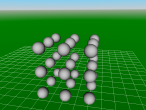Sodium Flouride 3D Model
My partner and I have choosen Sodium Flouride to base this blog on and create a virtual 3D model of it. In this blog I will show the 3D model of the Sodium Flouride made by using the VR maths program. Then I will give details on the composition, structure, and characteristics of the molecule. Further information, questions, interesting ideas and difficulties faced in the programming will be discussed. Links for the logo and code used will be provided.
Sodium Flouride Is an Ionic inorganic chemical compound with the formula NaF, and has many applications and uses due to its structure and properties. It is a compound of Sodium and Flouride, It is colourless (or white powder) solid and is odourless and has a salty taste. It has a crystalline structure as seen in the model above. It composed of a 1:1 ratio of Sodium (Na) and Flouride (F). So it has equal amounts of both Sodium and Flouride. It has a molecular mass of 41.988172 g/mol. It has a boiling point of 1704 degrees celsius and a melting of 993 degrees celsius.
This compound has many different ranges of uses in the real world. Sodium Flouride is an inorganic salt of flouride mainly used for treatment of tooth cavaitives and is a common ingredient in tooth paste. It is soluble in water and can be used in making tooth paste. Flouride binds to the calcium ions on the surface of our teeth and prevent corrosion of tooth enamel acids. This has also been in used in medicine to help increase bone desnity. The Sodium Toxic is highly toxic and can be lethal in high quantities. Which makes it great for uses in insecticides and rat poison. It is also used in cleaning agents for the same properties in the tooth pastes.
Further information: I would like to investigate further how the Flouride binds to the calicum in our bones and teeth to make them stronger and would also like to know, if the crystalline structure is beneficial to the binding and how when it is disolved in water how the structure and its role can be affected.
There were many interesting intereactions I had while using the VR Math Program and while using the code to make my model. Firstly it was great fun learning a whole new language of coding. Exploring what combinations and orders of code I had to do and I what I could produce with the program was very enjoyable and educational. I had learnt to shorten code by using the "To" and "repeat" function. The main difficulty faced was that repeating the bonds between the molecules were quite challenging so I had to do them one by one, resulting in a long line of code. Overall this program gave taught me a different view on 3D shapes and the maths behind it. The geometry and programming involved in the Vr Maths 2.0 program was very educational and I hope to see what other amazing things I myself and other people can do with it.
Link to Logo program:
Groups:























